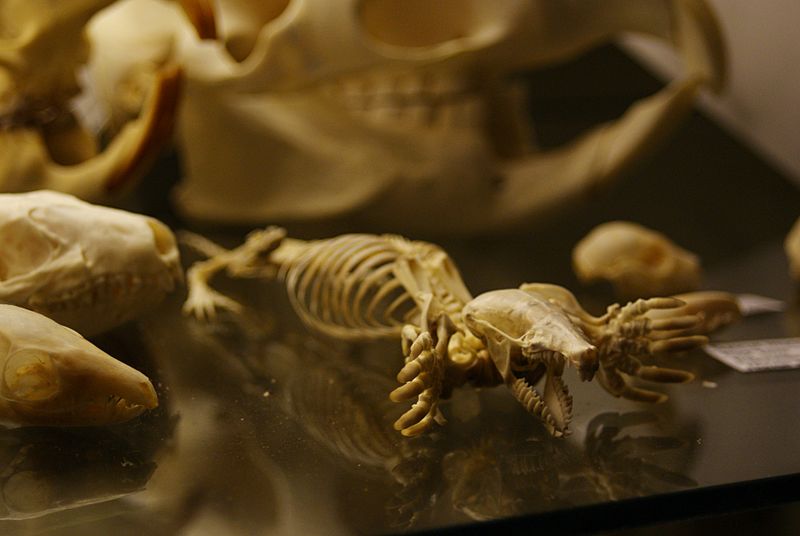Image: Eastern mole (Scalopus aquaticus) skeleton 2

Description: This is the Eastern mole (Scalopus aquaticus), a monotypic talpid mole in the New World mole raditation Scalopini (although one Chinese mole belongs to this group as well, strangely). It occurs in the eastern half of North American, extending slightly in Mexico and barely penetrating into Canada. This mole harbors some rather extreme fossorial (digging lifestyle) adaptations, including a robust manus (hand) as wide as it is long with large claws and a highly elongated sesamoid bone (this can be seen on the bottom of the hand on the right side of the photo). It also has an utterly massive olecranon process (extension of the ulna, basically a lever mechanism for foreleg movement) and wide, robust humeri and clavicles, that, like the manus, are more squarish overall rather then elongated (the humeri of this mole are also just really funky looking in general). But, as you can see, those scapula look rather skinny and puny. That's compensated by a bird-like keel on the manubrium of the sternum that serves to increase muscle attachment area for the back-and-forth movement of the forelegs. This basically means that moles utilize the same sort of mechanism as birds do in the air to "fly through the dirt." That's pretty neat. Some moles are aquatic, particularly the desmans. Despite the na#e "Scalopus aquaticus," however, the Eastern mole is not an aquatic species. That na#e comes from the fact that the type specimen was found dead in a body of water. Also, one more thing. Those teeth are pretty narly, eh? Don't underestimate moles, they're truly vicious predators. Skulls in the background: left front to back: Tree shrew (Tupaia sp.#, European hedgehog #Erinaceus europaeus#, North American porcupine #Erethizon dorsatum#. Now rightward: African Cape porcupine #Hystrix africaeaeustralis) and a lesser short-nosed fruit bat (Cynopterus brachyotis#. Right behind the mole's claws is an Asian musk shrew #Suncus murinus#, the largest species of shrew #which of course means the tree shrew on the left is not an actual shrew... it's really a basal euarchontan related to Primates in the order Scandentia#.
Title: Eastern mole (Scalopus aquaticus) skeleton 2
Credit: Eastern mole #Scalopus aquaticus) skeleton
Author: Dallas Krentzel
Usage Terms: Creative Commons Attribution 2.0
License: CC BY 2.0
License Link: https://creativecommons.org/licenses/by/2.0
Attribution Required?: Yes
Image usage
The following page links to this image:

